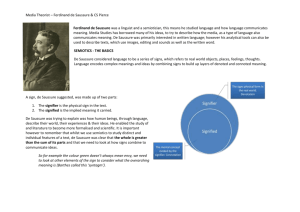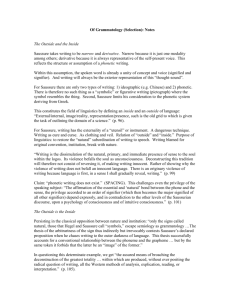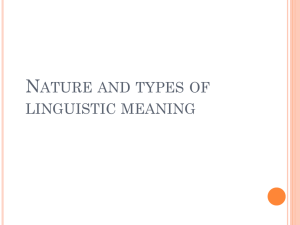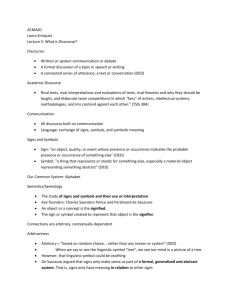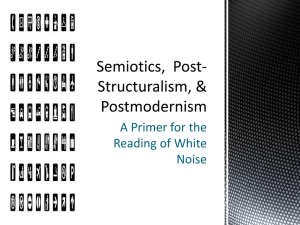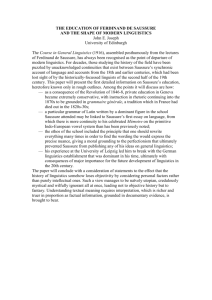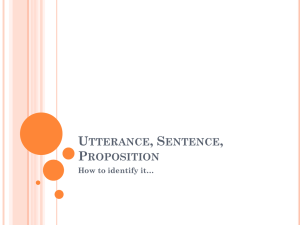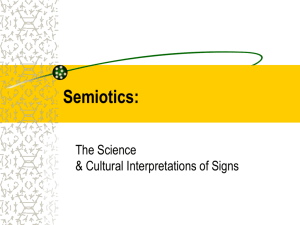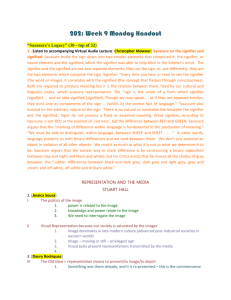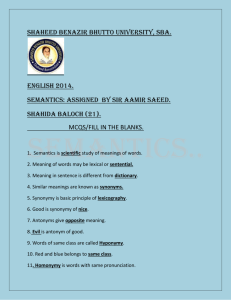COMMUNICATION AND LANGUAGE
advertisement
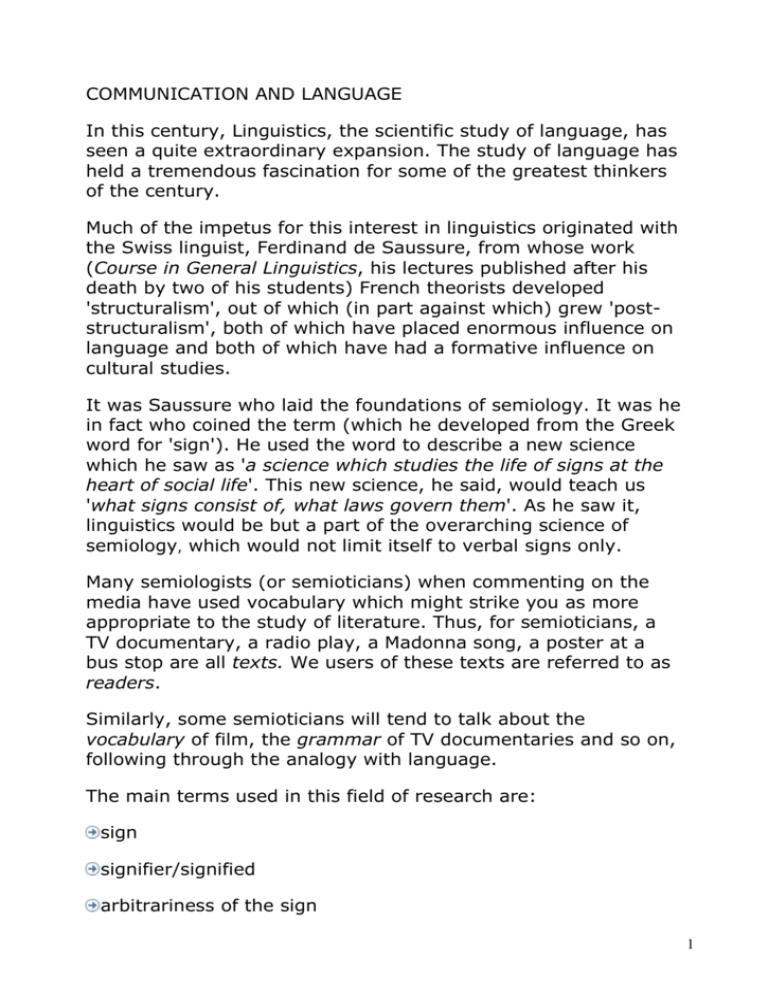
COMMUNICATION AND LANGUAGE In this century, Linguistics, the scientific study of language, has seen a quite extraordinary expansion. The study of language has held a tremendous fascination for some of the greatest thinkers of the century. Much of the impetus for this interest in linguistics originated with the Swiss linguist, Ferdinand de Saussure, from whose work (Course in General Linguistics, his lectures published after his death by two of his students) French theorists developed 'structuralism', out of which (in part against which) grew 'poststructuralism', both of which have placed enormous influence on language and both of which have had a formative influence on cultural studies. It was Saussure who laid the foundations of semiology. It was he in fact who coined the term (which he developed from the Greek word for 'sign'). He used the word to describe a new science which he saw as 'a science which studies the life of signs at the heart of social life'. This new science, he said, would teach us 'what signs consist of, what laws govern them'. As he saw it, linguistics would be but a part of the overarching science of semiology, which would not limit itself to verbal signs only. Many semiologists (or semioticians) when commenting on the media have used vocabulary which might strike you as more appropriate to the study of literature. Thus, for semioticians, a TV documentary, a radio play, a Madonna song, a poster at a bus stop are all texts. We users of these texts are referred to as readers. Similarly, some semioticians will tend to talk about the vocabulary of film, the grammar of TV documentaries and so on, following through the analogy with language. The main terms used in this field of research are: sign signifier/signified arbitrariness of the sign 1 semiotics and culture paradigm and syntagm denotation and connotation icon, index, symbol signification THE SIGN The initial idea was that a sign 'denotes' or 'refers to' something 'out there in the real world'. Words are labels attached to things. That seems a pretty sensible idea at first - we can readily see how 'London' can denote something 'out there'. But as soon as we get on to 'city', things start to get a bit vaguer. Which city? And when we get on to words like 'ask' or 'tradition', the relationship starts to fall apart. Saussure tried to get around this problem by saying that 'the linguistic sign does not unite a thing and a name, but a concept and a sound image’. Structuralism (i.e. the philosophy which derived later from Saussurean linguistics), then, 'brackets the referent'. In other words, the thing referred to (the referent) is taken out of the relationship and is replaced by 'concept'. SIGNIFIER AND SIGNIFIED Saussure actually saw the division of the sign into sound image and concept as a bit ambiguous. So he refined the idea by saying it might make things clearer if we referred to the concept as the signified and the sound image as the signifier. Saussure shifted the emphasis from the notion that there is some kind of 'real world' out there to which we all refer in words and is the same to all of us. Obviously, a language community has much of this real world in common, otherwise we couldn't communicate, but, for various reasons, the 'real world' which we articulate through our signs will be different for every one of us. 2 ARBITRARINESS Saussure stressed the arbitrariness of the sign as the first principle of semiology. By saying that signs are arbitrary, Saussure was saying that there is no good reason why we use the sequence of sounds 'sister' to mean a female sibling. We could just as well use 'soeur', 'Schwester', 'sorella'. For that matter, we could just as well use the sequence of sounds: 'brother'. Of course, as he pointed out, we don't have any choice in the matter. If we want to talk about female siblings in the English language, we can only talk about 'female siblings' or 'sisters'. Saussure saw language as being an ordered system of signs whose meanings are arrived at arbitrarily by a cultural convention. SEMIOTICS AND CULTURE Since the codes we use are the result of conventions arrived at by the users of those codes, then it is reasonable to suppose that the values of the users will in some way be incorporated into those codes. They will, for example, have developed signs to draw the distinctions between those things which are of particular significance in their culture. In other words, you might reasonably expect that the ideologies prevalent in those cultures will have been incorporated into the codes used. This implies that receiving a message (i.e. 'reading a text') is an active process of decoding and that that process is socially and culturally conditioned. PARADIGM AND SYNTAGM Saussure points out that the value of signs is culture-specific. The French mouton may have the same meaning as the English sheep, but it does not have the same value. Why? Because English has the terms mutton and sheep, a distinction which is not available in French. He emphasizes that a sign gains its 3 value from its relation to other similar values. Without such a relationship signification would not exist SYNTAGM This is a very useful insight in the analysis of signs. Language is linear: you produce one sound after another; words follow one another. When we think of signs interlinked in this way (for example she+can+go), then we are thinking of them in terms of what Saussure calls a syntagm. There is a syntagmatic relationship between them. PARADIGM However, at the same time as we produce these signs linked to one another in time, we also do something which is outside that temporal sequence: we choose a sign from a whole range of alternative signs. So, when a journalist writes: IRA terrorists overran an army post in Londonderry in Northern Ireland s/he chooses each sign from a range of alternatives. S/he could say: 'IRA active units', 'IRA paramilitaries', 'IRA freedom fighters', 'IRA lunatics' S/he could refer to Londonderry as 'Derry', the name more commonly used by nationalists; s/he could refer to Northern Ireland as 'Ulster', the 'Six Counties', the 'occupied counties' etc. When we look at this range of possibilities, we are examining a paradigm. We are examining the paradigmatic relationship between signs. Not uncommonly, syntagm and paradigm may be conceived of as two axes: 4 The signs signify because of their value, which derives from the relationship between them. How can you say that repeated occurrences of the same word are in fact the same word? Saussure gives the example of two 8.45pm expresses from Geneva to Paris, leaving at 24 hour intervals. For us, they are the same express, we are talking about the same entity when we refer to it, even though its carriages, locomotive and personnel are probably quite different on the two occasions. But it is not such material identities we refer to when we refer to the '8.45 Geneva-Paris express'; rather it is the relational identity given in the timetable - this is the 8.45 Geneva-Paris express because it is not the 7.45 Geneva-Heidelberg express, the 8.45 Geneva-Turin etc. We can examine the syntagms and paradigms in any medium. In Advertising as Communication Gillian Dyer takes the example of a photographic sign, namely the use of a stallion in a Marlboro ad. The paradigm from which the stallion is drawn includes ponies, donkeys, mules, mares. The connotations of stallion rely, on the reader's cultural knowledge of a system which can relate a stallion to feelings of freedom, wide open prairies, virility, wildness, individuality, etc.. Why were these choices made? What is communicated by them? One way to examine the ideological meaning suggested by the signs in the message is to see how the message would differ if another were chosen from the relevant paradigm. 5 DENOTATION AND CONNOTATION The phrases 'IRA terrorists' and 'IRA freedom fighters' denote the same people, but they connote something quite different. The sign we choose to use gains much of its meaning, not so much from what it is, but what it isn't. Its meaning is determined by the rejection of all the other signs we have chosen not to use. The paradigmatic analysis of a media text involves looking at the opposition between the choices which are actually made and those which could have been made. This structuralist analysis of texts tends to focus on binary oppositions. The syntagmatic analysis of a media text means studying its narrative structure. ICONS, INDEXES AND SYMBOLS At about the same time as Saussure was developing semiology, the American philosopher C. S. Peirce was developing semiotics (as it tended to be known in the US and is now generally known across the world). Following Peirce, semiologists (or semioticians) often draw a distinction between icons, indexes and symbols. Icons Icons are signs whose signifier bears a close resemblance to the thing they refer to. Thus a road sign showing the silhouettes of a car and a motorbike is highly iconic because the silhouettes look like a motorbike and a car. A very few words (so-called onomatopoeic words) are iconic, too, such as whisper, cuckoo, splash, crash. Symbols 6 Most words, though, are symbolic signs. We have agreed that they shall mean what they mean and there is no natural relationship between them and their meanings, between the signifier and the signified. Most words are symbolic signs. We have agreed that they shall mean what they mean and there is no natural relationship between them and their meanings, between the signifier and the signified. In movies we would expect to find iconic signs - the signifiers looking like what they refer to. We find symbolic signs as well, though: for example when the picture goes wobbly before a flashback. Certainly the 'real world' doesn't go wobbly when we remember a scene from the past, so this device is an arbitrary device which means 'flashback' because we have agreed that that's what it means. The road sign with the motorbike and car has, as we have just seen, iconic elements, but it also has symbolic elements: a white background with a red circle around it. These signify 'something is forbidden' simply because we have agreed that that is what they mean. Indexes In a sense, indexes lie between icons and symbols. An index is a sign whose signifier we have learnt to associate with a particular signified. For example, we may see smoke as an index of 'fire' or a thermometer as an index of 'temperature'. In old movies, when they need to show the passing of time, they may typically show the sheets bearing the days of the month being torn off a calendar - that is iconic, because it looks like sheets being torn off a calendar; the numbers 1, 2, 3 etc., the names January, February etc. are symbols - they are purely arbitrary; the whole sequence is indexical of the passing of time - we associate the removal of the sheets with the passing of time. SIGNIFICATION Signification and ideology Signs are not 'value-free' 7 Semiologists have emphasised that language exists as a structured system of symbolic representations. We do not live among and relate to physical objects and events. We live among and relate to systems of signs with meaning. In our interactions with others we don't use random gestures, we gesture our courtesy, our pleasure, our incomprehension, our disgust. The objects in our environment, the gestures and words we use derive their meanings from the sign systems to which they belong. The sign systems we use are not somehow given or natural. They are a development of our culture and therefore carry cultural meanings and values, cultural 'baggage'. They shape the consciousness of individuals, forming us into social beings. Any social practice has meanings which arise from the code it uses. Everything in our social life has the potential to mean. Not everything does mean. Wearing clothes in our society doesn't signify much in itself - though not wearing them certainly does! But what clothes we wear - that's a choice that signifies something. Since the codes we use are located within specific cultures, it should not be surprising that those codes express and support the social organization of those cultures. From this point of view there is no such thing as meaning which is independent of the ideological and political positions within which language is used. Thus, signification is not neutral or value-free. 8
